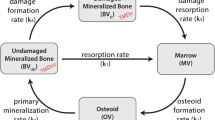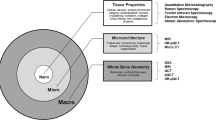Abstract
Summary
Bone remodelling is inhibited by high repetitive loading. However, in subchondral bone of racehorses in training, eroded surface doubled in association with fatigue fracture and there was greater surrounding trabecular bone volume suggesting trabecular modelling unloads the bone focally, allowing damage repair by remodelling.
Introduction
Remodelling replaces damaged bone with new bone but is suppressed during high magnitude repetitive loading when damage is most likely. However, in cortical bone of racehorses, at sites of fatigue fracture, focal porosity, consistent with remodelling, is observed in proportion to the extent of surrounding callus. Focal areas of porosity are also observed at sites of fatigue damage in subchondral bone. We hypothesised that fatigued subchondral bone, like damaged cortical bone, is remodelled focally in proportion to the modelling of surrounding trabecular bone.
Methods
Eroded and mineralizing surfaces and bone area were measured using backscattered scanning electron microscopy of post-mortem specimens of the distal third metacarpal bone in 11 racehorses with condylar fractures (cases) and eight racehorses in training without fractures (controls).
Results
Cases had a two-fold greater eroded surface per unit area at the fracture site than controls (0.81 ± 0.10 vs. 0.40 ± 0.12 mm−1, P = 0.021) but not at an adjacent site (0.22 ± 0.09 vs. 0.30 ± 0.11 mm−1, P = 0.59). Area fraction of surrounding trabecular bone was higher in cases than controls (81 ± 2 vs. 72 ± 2 %, P = 0.0020) and the eroded surface at the fracture site correlated with the surrounding trabecular area (adjusted R 2 = 0.63, P = 0.0010).
Conclusion
In conclusion, exercise-induced inhibition of remodelling is offset at sites of fatigue fracture. Modelling of trabecular bone may contribute to unloading these regions, allowing repair by remodelling.





Similar content being viewed by others
References
Frost HM (2000) Does bone design intend to minimize fatigue failures? A case for the affirmative. J Bone Miner Metab 18(5):278–282
Burr DB, Robling AG, Turner CH (2002) Effects of biomechanical stress on bones in animals. Bone 30(5):781–786
Danova NA, Colopy SA, Radtke CL, Kalscheur VL, Markel MD, Vanderby R, McCabe RP, Escarcega AJ, Muir P (2003) Degradation of bone structural properties by accumulation and coalescence of microcracks. Bone 33(2):197–205
Boyde A, Firth EC (2005) Musculoskeletal responses of 2-year-old Thoroughbred horses to early training. 8. Quantitative back-scattered electron scanning electron microscopy and confocal fluorescence microscopy of the epiphysis of the third metacarpal bone. N Z Vet J 53(2):123–132
Warden SJ, Hurst JA, Sanders MS, Turner CH, Burr DB, Li J (2005) Bone adaptation to a mechanical loading program significantly increases skeletal fatigue resistance. J Bone Miner Res 20(5):809–816
Rubio-Martinez LM, Cruz AM, Gordon K, Hurtig MB (2008) Mechanical properties of subchondral bone in the distal aspect of third metacarpal bones from Thoroughbred racehorses. Am J Vet Res 69(11):1423–1433
Rapillard L, Charlebois M, Zysset PK (2006) Compressive fatigue behavior of human vertebral trabecular bone. J Biomech 39(11):2133–2139
Jee WS, Li XJ, Schaffler MB (1991) Adaptation of diaphyseal structure with aging and increased mechanical usage in the adult rat: a histomorphometrical and biomechanical study. Anat Rec 230(3):332–338
Harrison SM, Whitton RC, Kawcak CE, Stover SM, Pandy MG (2010) Relationship between muscle forces, joint loading and utilization of elastic strain energy in equine locomotion. J Exp Biol 213(Pt 23):3998–4009
Firth EC, Rogers CW, Doube M, Jopson NB (2005) Musculoskeletal responses of 2-year-old Thoroughbred horses to early training. 6. Bone parameters in the third metacarpal and third metatarsal bones. N Z Vet J 53(2):101–112
Jackson BF, Goodship AE, Eastell R, Price JS (2003) Evaluation of serum concentrations of biochemical markers of bone metabolism and insulin-like growth factor I associated with treadmill exercise in young horses. Am J Vet Res 64(12):1549–1556
Whitton RC, Trope GD, Ghasem-Zadeh A, Anderson GA, Parkin TD, Mackie EJ, Seeman E (2010) Third metacarpal condylar fatigue fractures in equine athletes occur within previously modelled subchondral bone. Bone 47(4):826–831
Frost HM (1987) Bone "mass" and the "mechanostat": a proposal. Anat Rec 219:1–9
Jee WS, Li XJ (1990) Adaptation of cancellous bone to overloading in the adult rat: a single photon absorptiometry and histomorphometry study. Anat Rec 227(4):418–426. doi:10.1002/ar.1092270405
Stover SM, Ardans AA, Read DH, Johnson BJ, Barr BC, Daft BM, Kindu H, Anderson ML, Woods LW, Moore J, Stoltz J, Pool RR (1993) Patterns of stress fractures associated with complete bone fractures in racehorses. Proc Am Assoc Equine Pract 39:131–132
Kidd LJ, Stephens AS, Kuliwaba JS, Fazzalari NL, Wu AC, Forwood MR (2010) Temporal pattern of gene expression and histology of stress fracture healing. Bone 46(2):369–378
Entwistle RC, Sammons SC, Bigley RF, Hazelwood SJ, Fyhrie DP, Gibeling JC, Stover SM (2009) Material properties are related to stress fracture callus and porosity of cortical bone tissue at affected and unaffected sites. J Orthop Res 27(10):1272–1279
Muir P, Peterson AL, Sample SJ, Scollay MC, Markel MD, Kalscheur VL (2008) Exercise-induced metacarpophalangeal joint adaptation in the Thoroughbred racehorse. J Anat 213(6):706–717
Shelburne KB, Torry MR, Pandy MG (2006) Contributions of muscles, ligaments, and the ground-reaction force to tibiofemoral joint loading during normal gait. J Orthop Res 24(10):1983–1990
Li ZC, Dai LY, Jiang LS, Qiu S (2012) Difference in subchondral cancellous bone between postmenopausal women with hip osteoarthritis and osteoporotic fracture: implication for fatigue microdamage, bone microarchitecture, and biomechanical properties. Arthritis Rheum 64(12):3955–3962. doi:10.1002/art.34670
Parkin TD, Clegg PD, French NP, Proudman CJ, Riggs CM, Singer ER, Webbon PM, Morgan KL (2006) Catastrophic fracture of the lateral condyle of the third metacarpus/metatarsus in UK racehorses—fracture descriptions and pre-existing pathology. Vet J 171(1):157–165
Prewitt JM, Mendelsohn ML (1966) The analysis of cell images. Ann N Y Acad Sci 128(3):1035–1053
Muir P, McCarthy J, Radtke CL, Markel MD, Santschi EM, Scollay MC, Kalscheur VL (2006) Role of endochondral ossification of articular cartilage and functional adaptation of the subchondral plate in the development of fatigue microcracking of joints. Bone 38(3):342–349
Rubin J, Fan X, Biskobing DM, Taylor WR, Rubin CT (1999) Osteoclastogenesis is repressed by mechanical strain in an in vitro model. J Orthop Res 17(5):639–645
Hernandez CJ, Gupta A, Keaveny TM (2006) A biomechanical analysis of the effects of resorption cavities on cancellous bone strength. J Bone Miner Res 21(8):1248–1255
van Oers RF, van Rietbergen B, Ito K, Huiskes R, Hilbers PA (2011) Simulations of trabecular remodeling and fatigue: is remodeling helpful or harmful? Bone 48(5):1210–1215. doi:10.1016/j.bone.2011.01.011
Cardoso L, Herman BC, Verborgt O, Laudier D, Majeska RJ, Schaffler MB (2009) Osteocyte apoptosis controls activation of intracortical resorption in response to bone fatigue. J Bone Miner Res 24(4):597–605
Herman BC, Cardoso L, Majeska RJ, Jepsen KJ, Schaffler MB (2010) Activation of bone remodeling after fatigue: differential response to linear microcracks and diffuse damage. Bone 47(4):766–772. doi:10.1016/j.bone.2010.07.006
Hsieh YF, Silva MJ (2002) In vivo fatigue loading of the rat ulna induces both bone formation and resorption and leads to time-related changes in bone mechanical properties and density. J Orthop Res 20(4):764–771
Verborgt O, Gibson GJ, Schaffler MB (2000) Loss of osteocyte integrity in association with microdamage and bone remodeling after fatigue in vivo. J Bone Miner Res 15(1):60–67
Mori S, Burr DB (1993) Increased intracortical remodeling following fatigue damage. Bone 14:103–109
Norrdin RW, Stover SM (2006) Subchondral bone failure in overload arthrosis: a scanning electron microscopic study in horses. J Musculoskelet Neuronal Interact 6(3):251–257
Silva MJ, Touhey DC (2007) Bone formation after damaging in vivo fatigue loading results in recovery of whole-bone monotonic strength and increased fatigue life. J Orthop Res 25(2):252–261
Vetter A, Liu Y, Witt F, Manjubala I, Sander O, Epari DR, Fratzl P, Duda GN, Weinkamer R (2011) The mechanical heterogeneity of the hard callus influences local tissue strains during bone healing: a finite element study based on sheep experiments. J Biomech 44(3):517–523. doi:10.1016/j.jbiomech.2010.09.009
Epari DR, Schell H, Bail HJ, Duda GN (2006) Instability prolongs the chondral phase during bone healing in sheep. Bone 38(6):864–870
Shirazi R, Shirazi-Adl A (2009) Computational biomechanics of articular cartilage of human knee joint: effect of osteochondral defects. J Biomech 42(15):2458–2465
Ely ER, Avella CS, Price JS, Smith RK, Wood JL, Verheyen KL (2009) Descriptive epidemiology of fracture, tendon and suspensory ligament injuries in National Hunt racehorses in training. Equine Vet J 41(4):372–378
Verheyen KL, Newton JR, Price JS, Wood JL (2006) A case–control study of factors associated with pelvic and tibial stress fractures in Thoroughbred racehorses in training in the UK. Prev Vet Med 74(1):21–35
Verheyen KL, Wood JL (2004) Descriptive epidemiology of fractures occurring in British Thoroughbred racehorses in training. Equine Vet J 36(2):167–173
Verheyen K, Price J, Lanyon L, Wood J (2006) Exercise distance and speed affect the risk of fracture in racehorses. Bone 39(6):1322–1330
Boyde A (2003) The real response of bone to exercise. J Anat 203(2):173–189
Acknowledgments
Funding was provided by the Rural Industries Research and Development Corporation of the Australian Government and Racing Victoria Limited. We thank Mark Forwood for advice on the manuscript.
Conflicts of interest
None.
Author information
Authors and Affiliations
Corresponding author
Rights and permissions
About this article
Cite this article
Whitton, R.C., Mirams, M., Mackie, E.J. et al. Exercise-induced inhibition of remodelling is focally offset with fatigue fracture in racehorses. Osteoporos Int 24, 2043–2048 (2013). https://doi.org/10.1007/s00198-013-2291-z
Received:
Accepted:
Published:
Issue Date:
DOI: https://doi.org/10.1007/s00198-013-2291-z




